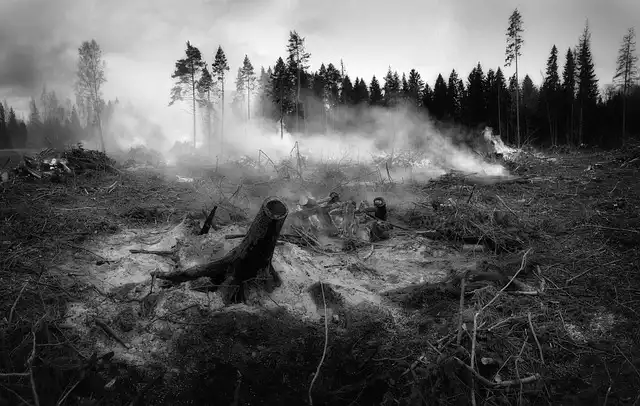Wildfire Smoke & Plant Health: Protecting Your Garden

Wildfire smoke impacts plant health, reducing photosynthesis and yields. Nutrient deposition from low-intensity fires can be beneficial. Proper watering and fire-adapted plants aid recovery. Avoid immediate fertilization.
These components, transferred on fallen leaves and soil, can enhance plant health and wellness. And, she adds, a current clinical research confirms that ‘plant roots directly soak up nitrogen from smoke and transportation it right into the above-ground components for inner blood circulation.’
Smoke’s Impact on Plant Health
Even if a fire isn’t close by, airborne contaminants can travel miles, Langelo points out. Most importantly, provide your yard time. As Langelo places it, ‘Plants have an incredible ability to recover, and they will certainly take their time doing it, since they have a built-in system where they feed themselves.’
‘ I talked to the horticulturist at the local botanic yard after a huge fire many years ago, asking about recommendations for their “fire risk-free plants” list and he stated to me, ‘Oh, that’s an old list that was done by a volunteer who took a number of leaves home and put them in his oven,’ Sterman recounts.
It’s approximated that wildfires damage, typically, about 3,500 frameworks yearly in the USA, according to the U.S. Forest Service. While that’s the average, the numbers can vary annually depending upon the number and seriousness of these wildfires. For example, in 2020, greater than 13,000 frameworks were damaged by wildfires in the Western USA alone.
Understanding Wildfire Damage Statistics
With any luck, and many thanks to firescaping methods, your home will still be standing after a nearby wildfire. It’s currently time to evaluate just how your yard has actually been impacted by smoke and ash. Our experts supply a couple of easy steps and give us a better understanding of what smoke can do to your yard.
However, several plants have defense reaction. Ponderosa pines, for example, have an amazing approach: ‘They in fact shut their stomata and held their breath up until it mored than,’ states Langelo, describing their feedback to wildfire smoke. This sort of adjustment is a pointer that nature often locates its own way to manage stress.
Plant Defense Mechanisms Against Smoke
California-based Nan Sterman is passionate concerning gardens and plants. Taking an all natural approach to attaching plants, people, and the world, she supports for yards that work with the local climate and environment rather than battle against them.
She includes that smoke from low-intensity fires can even benefit plants. The reason is due to nutrient deposition.
Expert Advice: Protecting Your Garden
When it pertains to protecting your home from fire, growing choices are just component of the formula. ‘A home’s susceptability depends on exactly how it is developed, how the structure is built, and its area,’ Sterman discusses.
One crucial pointer Langelo points out: Don’t feed as soon as possible. ‘That will stress them a lot more,’ she warns. Instead, wait till plants reveal signs of new growth, typically after two to four weeks, prior to applying light fertilizer.
Ellen Wells is a gardening communications professional with three decades experience writing about all aspects of the horticulture globe, and for GardeningKnowHow.com given that 2024. She focuses on retail gardening, vegetable horticulture and tropical plants. Ellen is based in southern New England where she gardens in area 7a.
Call me with news and supplies from various other Future brandsReceive email from us in behalf of our trusted partners or sponsorsBy sending your info you agree to the Terms & Problems and Personal privacy Policy and are aged 16 or over.
And for veggie gardeners, there’s even more trouble: ‘Smoke itself will certainly lower yields on vegetable plants,’ Langelo includes. ‘It minimizes photosynthesis, which stunts development and at some point can eliminate them, or make them more susceptible to diseases and parasites.’
Linda Langelo is a Colorado State College Extension Horticulture Professional, a participant of Yard Communicators International, and a normal factor to MarthaStewart.com horticulture articles. She also produces The Relentless Garden enthusiast Podcast and the Relentless Gardener Column, which won a Laurel Honor from Yard Communicators International. She attends blogger for AARP Colorado and AARP Maryland.
I chatted to the horticulturist at the regional botanic yard after a large fire several years back, asking regarding referrals for their “fire secure plants” listing and he stated to me, ‘Oh, that’s an old list that was done by a volunteer who took a bunch of leaves home and put them in his stove,’ Sterman states.
As Sterman encourages, keeping plants well-hydrated goes a lengthy means in safeguarding them from both fire and smoke. We have actually prepared an overview on deep sprinkling that will certainly aid your garden and landscape plants flourish and recoup, and look lovely.
‘ It’s more reason to utilize California citizens [in The golden state],’ she claims, ‘but it’s likewise a factor to utilize plants that are native to Mediterranean regions … due to the fact that they have progressed to recuperate from fire.’
The Benefits of Low-Intensity Fires
It’s a great idea to wash off leaves with tidy water to remove particulates that might interfere with photosynthesis or obstruction fallen leave pores. This additionally aids stop long-term accumulation and possible anxiety, specifically for vegetables and fragile ornamentals.
She adds that smoke from low-intensity fires can also profit plants. California-based Nan Sterman is enthusiastic concerning yards and plants. Taking an alternative method to linking plants, individuals, and the earth, she advocates for gardens that function with the regional environment and environment instead than battle versus them.,’ she states, ‘however it’s also a reason to make use of plants that are native to Mediterranean regions … due to the fact that they have developed to recoup from fire.’
Consider fire-adapted or native varieties if you’re motivated to replant or bring back a damaged location. Many also reply to “liquid smoke” as a germination sign, an innovative (and much safer) way to recreate fire’s favorable effects in a garden setup.
1 fire-adapted plants2 firescaping
3 garden recovery
4 nutrient deposition
5 plant health
6 wildfire smoke
« Lidl Slushy Maker: Affordable Iced Drink AlternativeHandheld Vacuum Hacks: Clean Anything, Anywhere! »
